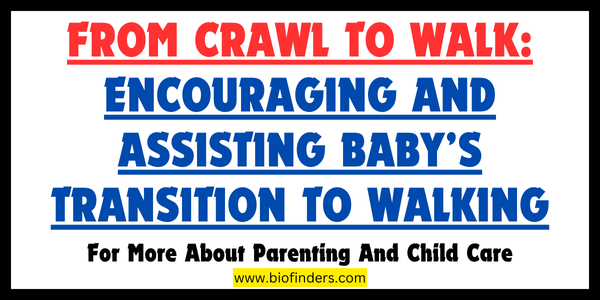This blog post is your guide to supporting your baby’s journey from crawl to walk. We’ll explore the signs that your little one is preparing to take those first steps, offer tips on creating a safe and stimulating environment, and address common concerns parents have about this exciting developmental phase.
UNDERSTANDING THE CRAWL TO WALK TRANSITION
Crawling is a crucial stage in your baby’s development. It strengthens the muscles needed for walking, improves balance and coordination, and helps them explore their surroundings. However, there’s no set timeline for when a baby transitions from crawl to walk. Most babies take their first steps between 9 and 18 months, with some starting earlier and others taking a bit longer.
Here are some signs your baby might be gearing up to walk:
Crawl to walk: STRONGER LEG AND CORE MUSCLES:
Crawling plays a significant role in building these essential muscle groups. Look for your baby pushing themselves up on their arms during tummy time or bouncing on their legs in a standing position.
Crawl to walk: PULLING TO STAND:
Using furniture for support, your baby will try to pull themselves up to a standing position.
Crawl to walk: CRUISING ALONG FURNITURE:
Watch out, world! Your baby will be cruising along furniture, holding on for support.
Crawl to walk: WEIGHT-BEARING ON LEGS:
When you hold them upright, your baby can put some weight on their legs and bounce slightly.
Even if your baby isn’t showing all these signs, don’t worry! Every baby develops at their own pace. However, if you have any concerns about your baby’s motor development, talk to your pediatrician.
CREATING A SAFE AND ENCOURAGING ENVIRONMENT FOR WALKING
Now that you have an idea of what to look for, how can you support your baby’s natural desire to walk? Here are some tips:
Crawl to walk: PROVIDE PLENTY OF FLOOR SPACE:
Clear a safe area for your baby to crawl and explore. This could be a designated play area in the living room or a play mat in their nursery.
Crawl to walk: ENCOURAGE TUMMY TIME:
As mentioned earlier, tummy time strengthens core muscles needed for walking. Aim for at least 10-15 minutes of tummy time several times a day.
Crawl to walk: OFFER STIMULATING TOYS:
oys that encourage reaching, grasping, and standing can motivate your baby to move. Consider push toys, walkers (used safely with supervision), or brightly colored balls to chase.
Crawl to walk: BABY-PROOF YOUR HOME:
Once your baby starts cruising, they’ll be exploring every corner. Ensure electrical outlets are covered, sharp corners are padded, and stairs are gated off.
Crawl to walk: POSITIVE REINFORCEMENT:
Celebrate your baby’s attempts to walk, no matter how wobbly! A smile, a clap, or a verbal “good job” can work wonders and encourage them to keep trying.
BAREFOOT TIME:
Walking barefoot allows your baby to feel the ground beneath them, improving balance and coordination.
WALKING TECHNIQUES AND SAFETY TIPS
While it’s tempting to want to help your baby take their first steps, it’s important to let them develop naturally. Here’s what to avoid:
USING WALKERS:
Studies have shown that walkers can actually hinder a baby’s natural development.
WALKING WITH A HARNESS OR SUPPORT:
This can restrict your baby’s natural movements and delay their ability to balance independently.
Here are some safe ways to assist your baby during this transition:
HOLD THEIR HANDS AS THEY STAND:
This can provide initial support and confidence as they practice weight-bearing on their legs.
ENCOURAGE CRUISING ALONG FURNITURE:
This allows them to build strength and balance before taking those first independent steps.
COMMON CONCERNS AND WHEN TO TALK TO YOUR PEDIATRICIAN
It’s natural to have questions and concerns when your baby starts walking. Here are some common concerns and when to talk to your pediatrician:
MY BABY IS OVER 18 MONTHS AND NOT WALKING:
While most babies take their first steps between 9 and 18 months, some may take a bit longer. However, if your baby isn’t showing any signs of wanting to walk or isn’t pulling to stand by 18 months, talk to your pediatrician. They can assess your baby’s development and rule out any underlying issues.
MY BABY IS TOE-WALKING:
Occasional toe-walking is normal in young children. However, if your baby walks exclusively on their toes after 18 months, consult your pediatrician.
MY BABY IS WALKING WITH A LIMP:
A limp can have various causes. If your baby limps consistently or seems to be in pain, talk to your pediatrician to determine the underlying issue.
MY BABY FALLS FREQUENTLY:
As they learn to walk, it’s natural for babies to take some tumbles. However, if your baby falls excessively or seems to have difficulty with balance, talk to your pediatrician.
THE JOY OF THE JOURNEY
Watching your baby take their first steps is a truly special moment. But remember, the journey to walking is just as important as the destination itself. By providing a safe and stimulating environment, offering positive reinforcement, and letting your baby explore at their own pace, you’ll be nurturing their development and creating lasting memories together. Embrace the wobbly steps, the giggles, and the inevitable falls – they’re all part of the incredible adventure of watching your baby grow and learn to walk!
Remember, you are your baby’s best advocate. Trust your instincts and don’t hesitate to reach out to your pediatrician if you have any concerns about their development.




Leave a Reply